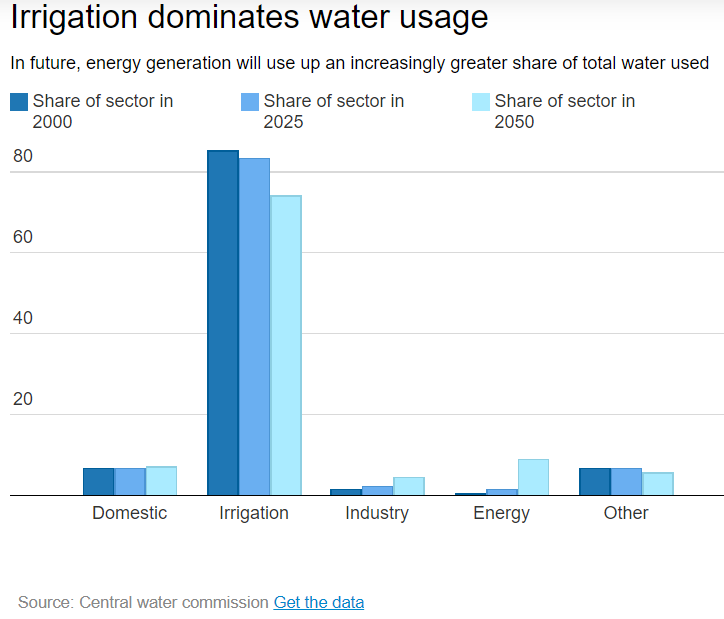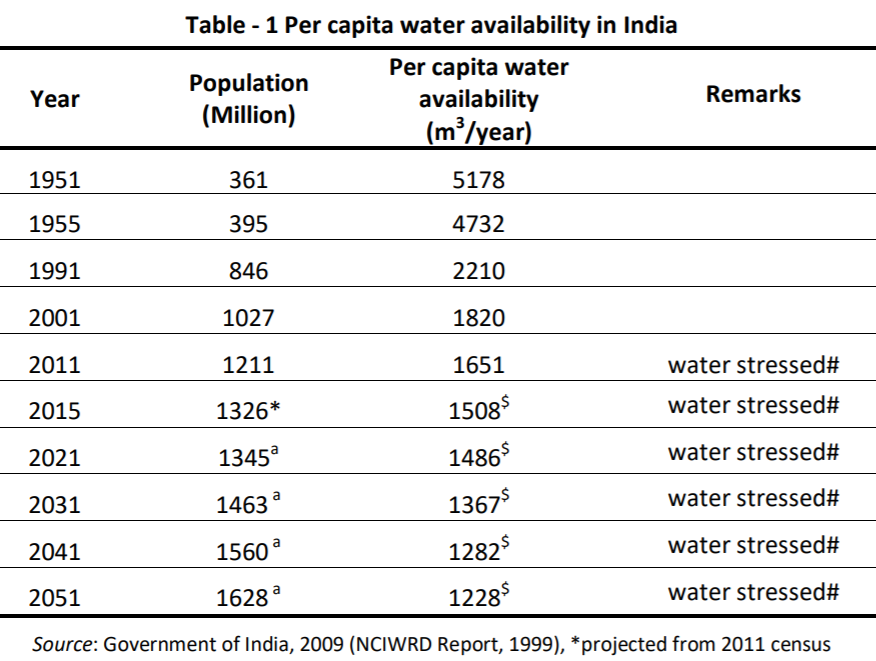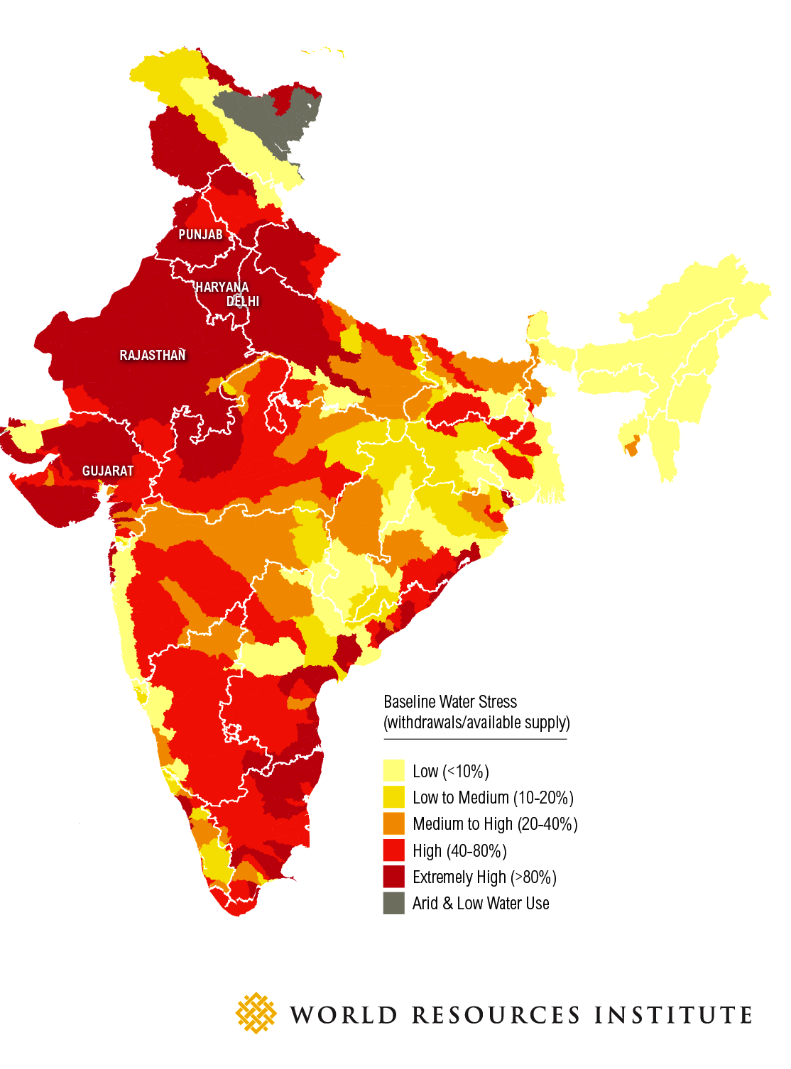Water Crisis in India
2021 JAN 6
Mains >
Geography > Resource geography > water management
IN NEWS:
- Speaking at the 5th India Water Impact Summit, Union Minister of Jal Shakti Gajendra Singh Shekhawat said that the world needs to come together to meet the challenges of the water sector in the same way as the world has united in fighting the COVID-19 pandemic.
BASIC FACTS:
Distribution of Water Resources in The World:
- Oceans: 1350 million BCM volume (97%)
- Freshwater: 38 million BCM volume (3%), comprising of i) Surface water (E.g. River, Lake, Backwaters, Ponds, Tanks), ii)Ground water, iii) Soil moisture, iv) Ice cap and Glaciers and v) Water vapour in atmosphere
WATER RESOURCES IN INDIA:
- India has 4% of world’s water resources but supporting 16% of world’s population

WATER UTILIZATION IN INDIA:

WATER STRESS AND WATER SCARCITY:
- Annual per-capita water availability of less than 1700 cubic meters is considered as water stressed condition,
- Annual per-capita water availability below 1000 cubic meters is considered as a water scarcity condition
FACTS/REPORTS/INDEXES DEPICTING WATER CRISIS IN INDIA:
1)per capita water availability in India:

2) NITI Aayog Composite Water Management Index 2018 found that 600 million people in India being under water stress which is the worst water crisis in history.
3) UN Water Development Report 2019 found that 54% of groundwater declined in just seven years
4) According to the World Resources Institute, 54% of the total area in India is facing water stress. India was ranked 13th among the 17 most water stressed countries of the world.

REASONS FOR THE WATER CRISIS:
A) SOCIAL:
- Population expected to reach 1.6 billion in 2050 which increases water as well as food grain requirement
- Increasing urbanization led to increased water demand in cities
B) ECONOMIC:
- Increasing Per capita income led to increased consumption of sugar,fruits,vegetables,milk, eggs etc which led to increased water demand
- Irrigation intensive agriculture through canals, tanks and wells or tubewells especially in agricultural regions like Punjab,West UP and Haryana
- Water intensive industrial growth
- Dependence on thermal power generation (86% according to CEA ) which is highly water intensive
- Inefficiency in water distribution and management e.g. open canals
- Infrastructural gaps in water conservation
C) ECOLOGICAL:
- Water Pollution from agriculture, industries and households leading to eutrophication.
- Decline in groundwater table leads to increased concentration of arsenic and fluoride.
- Saline water intrusion lowers the quality of freshwater sources
- Deforestation decreasing water holding capacity of soil
D) GEOGRAPHIC:
- Crystalline rocks decrease percolation and groundwater recharge
- Difference in rainfall distribution creates droughts in regions e.g. Rajasthan
- Drier regions becoming more drier due to climate change
E) POLITICAL:
- Interstate water disputes hampers efficient utilisation of water e.g. Cauvery dispute
- Comprehensive water framework law is absent in India
- Policy focus on surface irrigation led to neglect of Ground water exploitation
- Unrealistic pricing of water led to wastage of water
- Privatisation of tankers led to more ground water extraction
MEASURES TAKEN BY GOVERNMENT
- Jal Shakti Abhiyan- Water conservation and irrigation efficiency campaign
- World Water Day celebrated on March 22 to create awareness on water conservation
- Water Scarce Cities Initiative by World Bank to which India is a party : Integrated approach to manage water resources and service delivery
- Har Ghar Jal-Initiative to provide 100% piped water by 2030
- National Rural Drinking Water Program to provide 100% drinking water access in rural habitations
- Water Conservation Fee by CGWA for domestic and industrial users , the revenue being used to fund GW recharge projects
- Jal Mani Program to address water quality issues in rural areas
- Swajal Yojana: To provide Sustained DW supply powered by Solar energy
- Atal Bhujan Yojana a 6000crore project aided by World Bank
- Nal Se Jal to provide piped water for every rural home
WAY FORWARD
- AFFORESTATION: increase water holding capacity of soil
- RESTORE FLOOD PLAINS: increases groundwater recharge and decrease floods
- WETLAND RESTORATION: reduce soil erosion and flooding, create Riparian buffer strip near streams to protect them from impact of adjacent land use
- IMPROVE AGRICULTURAL PRACTICES:
- Micro Irrigation techniques like Drip or sprinkler irrigation using sensor based technologies
- Organic farming reduces fertilizer and pesticide use
- Diversify crops with less water intensive ones
- Conservation tillage
- System of rice intensification technique to reduce water and labour intensity
- Participatory irrigation management
- WATER POLLUTION MITIGATION
- Increase Sewage treatment plants and recycle to industries
- Household wastes be used for kitchen gardening
- Strict law enforcement of Water Act 1974 and Environment Protection Act 1986
- Monitoring surface water with help of civil society organisations
- Implement National river water interlinking project
- Rationalize water pricing to disincentivize water wastage
- Formulation of comprehensive National water framework law
- Promote a decentralised approach, with a key focus on water conservation, source sustainability, storage and reuse wherever possible
|
CASE STUDY:
CHINA’S SPONGE CITIES: A Sponge City is a city that has the capacity to mainstream urban water management into the urban planning policies and designs. It should have the appropriate planning and legal frameworks and tools in place to implement, maintain and adapt the infrastructure systems to collect, store and treat (excess) rainwater.
|
PRACTICE QUESTION:
Q. Examine the role of water in ensuring inclusive growth in India?



